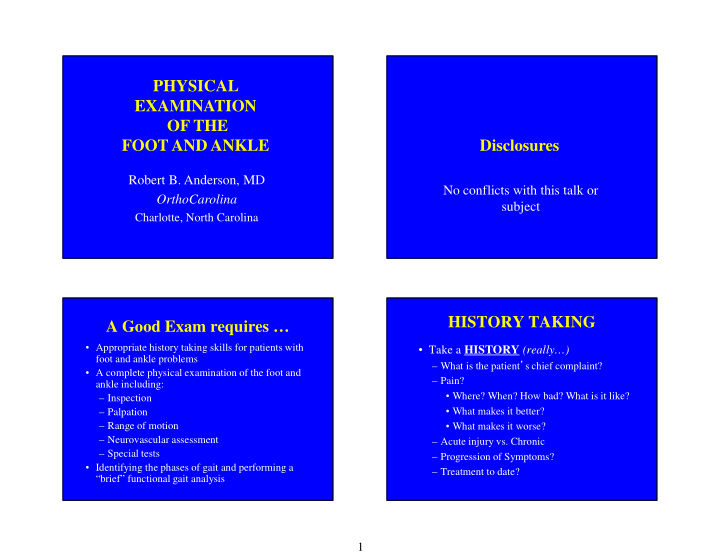



PHYSICAL EXAMINATION OF THE FOOT AND ANKLE Disclosures Robert B. Anderson, MD No conflicts with this talk or OrthoCarolina subject Charlotte, North Carolina HISTORY TAKING A Good Exam requires … – What is the patient ’ s chief complaint? • Appropriate history taking skills for patients with • Take a HISTORY (really…) foot and ankle problems • A complete physical examination of the foot and – Pain? ankle including: • Where? When? How bad? What is it like? – Inspection • What makes it better? – Palpation – Range of motion • What makes it worse? – Neurovascular assessment – Acute injury vs. Chronic – Special tests – Progression of Symptoms? • Identifying the phases of gait and performing a – Treatment to date? “brief” functional gait analysis 1
HISTORY TAKING: The PHYSICAL EXAM Background Information • Must have knowledge of the • Any Previous Injuries anatomy!!! • Past Surgical History • Past Medical History • Medications • Allergies • Social History – Work situation (laboring type job?) – Home situation STEPS in the PHYSICAL EXAM INSPECTION Must see from the knee down!!! • Inspection – Watch them walk/stand What do you see? • Palpation • Alignment (neutral? valgus? varus?) • Range of motion – Knees, hindfoot, forefoot • Foot shape: Flatfoot? High arched? • Neurovascular Normal? assessment • Toe shape: Clawed, Hammer, Mallet toes, Hallux valgus or varus? • Special tests 2
INSPECTION PALPATION What do you see? • Where does it hurt? What do you feel? Sitting exam = • Surface Anatomy is key!! • Swelling? Masses? – Pathology can be accurately localized • Discoloration? • Anterior talofibular ligament vs talar dome – Ligaments, Bones, Tendons hurt where they are • Scars? / Cuts? / Abrasions? injured Plantar callosities? / Ulcers? • Neuropathy is the exception! RANGE OF MOTION RANGE OF MOTION ANKLE MOTION (knee straight & bent) Accurately assess range of motion including: • Ankle dorsiflexion • ankle dorsiflexion (knee straight) – Reduce the talonavicular joint • ankle dorsiflexion (knee bent) • ankle plantar flexion – Knee straight (gastrocnemius under tension) • hindfoot inversion and eversion – Knee bent (Soleus only) • medial column mobility • Ankle plantarflexion Thumb on talar neck • 1 st MTP joint motion Navicular reduced • interphalangeal motion • Abduction/Adduction of Transverse Tarsal Joints 3
RANGE OF MOTION RANGE OF MOTION HINDFOOT INVERSION & EVERSION MEDIAL COLUMN MOBILITY • Compare to contralateral side • Stabilize 2 nd MT head • Assess midpoint • Assess dorsal & plantar movement of 1 st MT • Translation >1cm suggests hypermobility • Increased Movement? 1st TMT joint N-C joint T-N joint Inversion Eversion RANGE OF MOTION RANGE OF MOTION FIRST MTP JOINT INTERPHALANGEAL JOINT MOTION MOTION • Test individual joints • Standing to assess • Fixed contracture? Painful? dorsiflexion • Limited in hallux rigidus • Pain at extremes of motion? • Does hallux valgus deformity reduce? 4
NEUROVASCULAR NEUROVASCULAR ASSESSMENT ASSESSMENT PERIPHERAL NERVES • Nerve Function INERVATING THE FOOT – Sensation • Superficial Peroneal Nerve – Reflexes • Deep Peroneal Nerve – Motor Strength • Saphenous Nerve • Vascular Status • Sural Nerve – Distal pulses – Capillary refill • Tibial nerve NEUROVASCULAR NEUROVASCULAR ASSESSMENT ASSESSMENT SENSATION REFLEXES – Light touch – 2 point discrimination • Ankle Reflex – Vibration sense – S-1-2 Dermatome • Neuropathy – Loss of “ protective ” sensation – Loss of 5.07 monofilament sensation 5
NEUROVASCULAR NEUROVASCULAR ASSESSMENT ASSESSMENT MOTOR STRENGTH ANKLE DORSIFLEXION • Graded 0-5 • Tibialis Anterior 5 = Full strength • EHL 4 = • EDL 3 = Antigravity strength 2 = 1 = Flicker 0 = No contraction NEUROVASCULAR NEUROVASCULAR ASSESSMENT ASSESSMENT EVERSION INVERSION • Peroneus Longus • Posterior Tibialis • Peroneus Brevis • Flexor Digitorum Longus • Flexor Hallucis Longus • Don’t get fooled by the ATT 6
NEUROVASCULAR NEUROVASCULAR ASSESSMENT ASSESSMENT DISTAL ARTERIAL SUPPLY PLANTAR FLEXION • Posterior Tibial Pulse • Gastrocnemius • Dorsalis Pedis Pulse • Soleus • Heel Rise – 1 = 4/5 strength – 30+ = 5/5 strength SPECIAL TESTS SPECIAL TESTS SINGLE LEG HEEL RISE • Special Test = Physical examination QUESTION: Does this patient have a maneuvers designed to answer a specific functional posterior tibial tendon? question • Yes, if patient can perform a toe rise with inversion of the heel • Normal gastrocsoleus strength = 30 calf raises 7
SPECIAL TESTS SPECIAL TESTS ANTERIOR ANKLE DRAWER TEST THOMPSON TEST QUESTION: Does this patient have an QUESTION: Does this patient attenuated or incompetent anterior talofibular ligament? have an intact Achilles tendon? • Stabilize distal tibia and internally rotate • Patient positioned prone with the foot slightly. Then apply a steady knee bent 90 degrees anteriorly directed force to the calcaneus • Squeeze calf and look for ankle • How much anterior translation of the foot plantar flexion occurs? • Plantar flexion = intact Achilles • Compare to the contralateral side GAIT ANALYSIS GAIT ANALYSIS PHASES OF GAIT OBJECTIVES • Identify the phases of gait and perform a “brief” functional gait analysis Heel Rise Toe Off Flatfoot Heel Strike – Ask the patient to walk up and down the STANCE PHASE SWING PHASE hallway 8
GAIT ANALYSIS GAIT ANALYSIS STRIDE LENGTH FOOT PROGRESSION • Symmetrical side-to-side? • Symmetrical? • Shortened? • Neutral? • Internal? • External? Summary GAIT ANALYSIS Does one side have: ASYMETRY? Understand the Anatomy Ask the Right Questions • Decreased stride length? Watch the Walk • Decreased stance time? Assess Alignment • Increased trunk shift? Touch the Patient • Increase or decreased foot progression angle? • Abnormal heel to toe progression? Thank You • Foot drop? 9
Recommend
More recommend